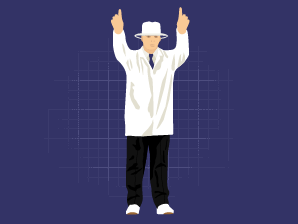



 and the factory (Is it the design factory we try to make? or not? )...
and the factory (Is it the design factory we try to make? or not? )...
As we discussed in Hobgoblin, the easiest and cheapest way to distinguish Umpire is wearing Hi-Vis coat. Available for 4.46 pounds in B&Q.
http://nextday.diy.com/app/jsp/product/productPage.jsp?productId=36850
It may be worn with the overall as well.
The fashion probably depends on his/her roles in the space but I'm still not sure how the umpire plays there.
Possible roles are...
: acts as a chairman.
: says "start" and "stop" as a time keeper.
: judges good or bad design.
: states briefs.
: adds fancy details of briefs. (eg. some umpire says "draw within a minutes" but some may say "draw without using hands")
: shouts with a megaphone.
: slaps a person who doesn't follow umpire's rule.
: gives a yellow or a red card to a person who doesn't follow umpire's rule.
: forces participants to salute the god of design or something.
And also, I think the umpire doesn't have to be alone. They can be like a commentator and a narrator of over-by-over sports broadcasting. Or they can be like a reporter and a cameraman with a real video camera connected to a screen (like Milan did at Pirate Utopias). Then, we can broadcast activities of inside the factory to outside. It also can play as records of our show as well as make more gameshow feelings.


It's not always visitors have enough time to join and actually make something in our workshop. I think majority of them are moving to the next booth within 5 to 10 minutes. We should think how to entertain them in a short time even if they're not joining to make.
--------------------------------------------------------------------------------------------
I just come up with an idea for categorising switchboard briefs. The idea is we could divide briefs into human body parts like head, eye, ear, mouth, hand, etc. then, make a switchboard for these parts. If the board indicates "head", it means "brainstorming" or other conceptual processes.
For example,
Head: Conceptual process: eg) brainstorming
Hand: Making process: eg) paper-prototyping
Eye: Visual process: eg) photoshoping
Ear: Sound process: eg) Finding sound inspirations of the object
Mouth: Presentation process: eg) Pitch
The good point of categorising is its flexibility. We can start to make a switchboard machine as soon as we decide categories. It's more flexible than putting specific activities on the switchboard. I'm sure some new idea for activities will be come up during show and we will want to add it, or if some problem happens for some activity, we don't have to put X on the board.
I Like it!!
ReplyDeleteyuki = genius
ReplyDeletehey yuki - they've made the switchboard so that things can be changed whenever we want just by ripping a piece of paper off and replacing it with a new activity.
ReplyDelete